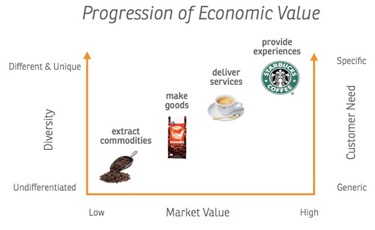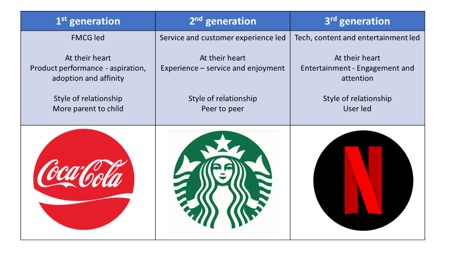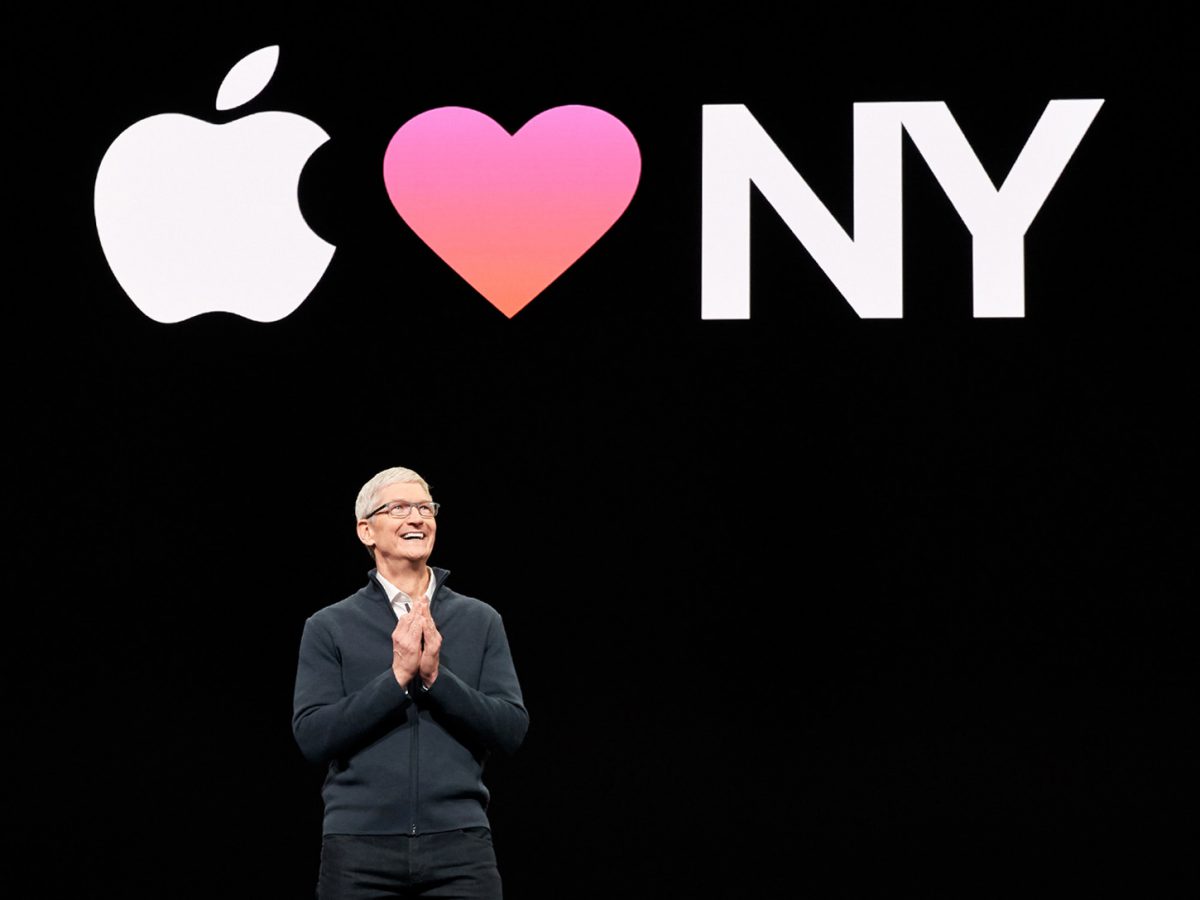We have now entered the next generation of branding.
It’s a generation characterised by technology, content or entertainment. Many of the brands are IP-led or platforms, acting as enablers and facilitators. Many are disrupting long-established, existing markets from music with the likes of Spotify, to medicine with brands like Pillpack. As has often been pointed out, many don’t own or produce anything physical.
They are however seeing phenomenal returns, and their growth rates can be truly exponential. Many of those running previous generation brands have never experienced this, and some cannot even visualize it.
A brief history of branding
The earliest known example of a branded product was the ‘Fortis’ oil-burning lamps first made in Roman times and produced in Lombardy up until the 2nd Century. Many would see Lord Lever’s creation of Sunlight soap as the birth of modern branding but branding really took off post the Second World War. This first generation of brands was dominated by fast-moving consumer goods and for many years Coca-Cola and Marlboro topped the lists of the world’s most valuable brands.
The latter part of this generation of brands saw the concept of branding evolve beyond its original meaning as “A name, term, symbol or design, or a combination of them identified to signify the goods and services of one seller or group of sellers and to differentiate them from those of competitors.” It became something bigger; a concept that was more than the product itself and akin to a philosophy based on values, beliefs and personality.
Then as we approached the 21st Century a new generation of branding emerged. It would be an age led by service and customer experience brands, famously summed up in a chart showing the progression of the economic value of coffee from commodity to an experience, and the publication of The Experience Economy.

It was driven by a combination of factors, including increased consumer affluence and time poverty, service providers waking up to the benefits of modern branding and from the increasing ability of first generation FMCG companies to copy each other’s products which meant their focus shifted more to customer experience as a means of maintaining differentiation – It wasn’t just what you did but how you did it, that differentiated you. Banking, retailers and other service providers came to the fore and poached the leading FMCG marketers to bring their expertise to bear on their brands.
Best practice service branding could be described as the same but different to classic FMCG branding. Many of the approaches and the models were the same but there was a greater emphasis on people; customer touchpoints and the customer experience. The now well-known adage of “everyone is in marketing” was another difference and one that was reverse engineered in FMCG brands.
However, it was also the time when the foundations of the third generation were being laid. Tech-led, communications brands were growing quickly driven by development of digital technology; a trend which also influenced the way marketing was being conducted.
The period also saw an ever-increasing pressure on marketing departments to deliver short-term sales and ROI, something that is often at odds with the desire for long-term brand building. And while there is a recent trend towards brands having purpose which suggests a need to invest in the brand, purpose is far from something all brands have adopted. A recent TVE study showed that of the top 100 most valuable brands only 14 had purposes.
What makes them so successful?
Today, the third generation of brands are harnessing technology to create a world of increasingly seamless, frictionless convenience – with one click purchases, speedy delivery and the option to return. In a world that feels time-poor they address people’s needs – fast and easily.

Many have adopted and adapted their business models so things can be tried, and sometimes used for free. How much would you pay for a search engine if brands like Google and others weren’t ‘free’. Mobile games had to adapt to a play-for-free world and transitioned to a ‘freemiumisation’ and ad funded model. It’s a winning formula because we consumers are prone to think the best things in life are free. We don’t seem to mind, or simply ignore, the fact that we’re paying with our data. We value the services these brands offer above our privacy, and indeed many of this new generation of brands actively encourage and facilitate us to share our lives on-line for the world to see.
They have, use and sell huge amounts of data to great effect allowing them to understand their customers and keep their fingers on the pulse in real-time. This means, among other things, they can create better segmentations and target the people in them more effectively.
This ability to have their fingers on the pulse helps them know what’s happening now and also provides them with the impetus to stay agile, changing and adapting at speed. They are good at ‘going native’, adapting to become essential to a local market, but doing so around the world.
Unlike previous brands, who worried about the half of advertising they knew didn’t work, and made do with ‘opportunities to see’, these brands place their money on attention and engagement. They like it ‘sticky’.
They have adopted the proven techniques of the entertainment business:
Apple’s strategy when releasing a new iPhone is for CEO Tim Cook to announce it at MacWorld. To tease the audience with some of the key features. Sounds like a studio announcing a new film and some of the key stars they have lined up doesn’t it?
Later they will tell us about the release date and the prices. Ok, so the studio doesn’t tell us the price at our local cinema but both studios and third generation brands know a release date is a good way to help build excitement and anticipation around the day.
Apple will then target key influencers which sounds a bit like the screening for film critics.
The desired result for both is queues building up on the day or even the day before the release.
But what about the brand?
How many people have you seen who have a Harley Davidson or Nike tattoo? How many people have you seen with an Amazon or Airbnb tattoo? Personally, I have seen hundreds of the former and not one of the latter.
The best third generation brands are undoubtedly experts at marketing, especially performance marketing, but there are questions around their belief in, and commitment to branding.
Are they really trying to build a brand or are they just successful business models which use a brand as means of identification? Is it enough for them to brand their business and not be a brand-led, purpose-driven brand? Are we going back to the days of a Kotler-like definition of branding?
Their focus is on growth and short-term returns – making hay while the sun shines. This makes them the darlings of finance directors and venture capitalists. However, taking the sun analogy further, there seems to be a built-in acceptance that their lifespans might be shorter. As Icarus, Friends Re-United, Palm and others have discovered, flying fast and high can lead to your wings getting burnt by the sun.
Another way this shift is reflected is in how the Chief Marketing Officer is either being replaced or required to answer to a Chief Growth Officer, Chief Demand Officer or Chief Customer Experience Officer?
A mutual appreciation society?
The brands of the first two generations, the FMCG-led and the service-led eras, aren’t going to completely disappear but their relative importance will decline. They need to learn some ‘new tricks’ and adopt some of the characteristics of the new kids on the block.
However, it may also be that those new kids will want to build to last and so want to learn from what has gone before. It will be interesting to see if they are up for the challenge and if they say they want to turn themselves into more fully rounded brands and more importantly, whether their actions will reflect this stated intent.
Featured image: Apple































